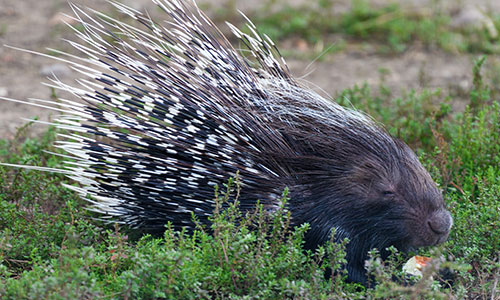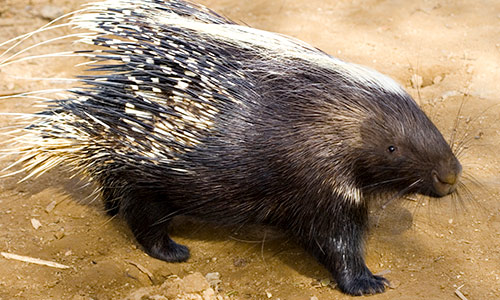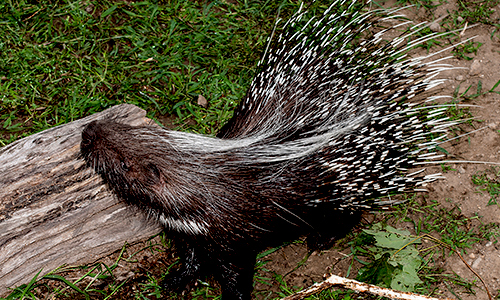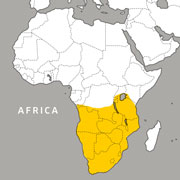Appearance:
Cape porcupines' bodies are covered with flat, bristly hairs, and they have large quills on their posterior back and sides that range from a couple of inches to a foot in length. Their short rump spines and the underside of their tails are white. The quills are striped black and white, which serves as a warning to potential predators. They can erect their crest and quills at will, which makes them appear large and threatening. Porcupines also have a group of hollow quills on their tails which rattle when shaken. The quills detach readily if touched by a predator, but grow back quickly. Females may be larger than males, but otherwise, the sexes are alike in appearance and are difficult to distinguish.
Cape porcupines are Hystricomorph rodents, and surprisingly, are not closely related at all to New World porcupines. They're more closely related to agoutis, capybaras or even guinea pigs.
Size:
- Length: Up to 39 inches; tail 4 to 6.5 inches
- Weight: 40 to 66 pounds
Reproduction:
Litters are usually born between August and March. One to four Cape porcupine offspring (the average is two) are born after a gestation of three months. At birth, porcupettes are approximately 3% of the female's body weight and typically range between .66 to 1 pound. They're born with their eyes open and incisors that have already broken through the gums. Their quills are soft at birth, but rapidly harden. Female porcupines have teats on their sides just behind their front legs, and they lay sternal to nurse their offspring. The young nurse for three to four months and reach full size by one year of age. Female porcupines reach maturity by 9-16 months, while males reach maturity by 8-18 months. Females can give birth one to two times per year.
Median Life Expectancy:
12-14 years
Habitat/Range:
Cape porcupines are found in sub-Saharan Africa and are able to inhabit many different types of habitats as long as cover and vegetation are present.
Diet:
African spurred porcupines are primarily herbivores, or plant-eaters. They feed on roots, bulbs, tuber and bark. Occasionally, they will gnaw on old carcasses and bones to get calcium and to wear down their teeth.
Behavior:
Cape porcupines are solitary or found in small family groups. The male and female raise the young together as a monogamous pair. The offspring will start to disburse at sexual maturity, and the male will often drive out his male offspring first.
Cape porcupines are nocturnal, and, unlike new world porcupines, they're exclusively terrestrial. They may be found in small family groups, but they tend to forage alone and to follow the same paths searching for food. They'll modify natural shelters, such as caves, crevices or burrows created by other animals. If no suitable shelter is available, they'll dig their own dens, which can be up to 20 meters long.
When threatened by predators, Cape porcupines will hide in their shelter when available with their heads facing in and their quills erect, which makes them almost impossible to dislodge. If cornered in the open, they respond very aggressively, erecting their sharp hollow "rattle" quills and running sideways or backwards to drive them into their attacker. Porcupines don't actually "shoot" their quills, but shed them upon impact, so they become imbedded in an attacker. Porcupines may freeze if they hear a large predator.
They have long, sensitive whiskers that they use to find their way around in their burrows or at night. As rodents, their incisors grow continuously, so they need to gnaw on items to keep them sharp and worn down. They'll gnaw on small branches and even bones when they can find them, which provide a good source of calcium.
This porcupine's communication is based primarily on smell, as they scent mark their territories with strong-smelling urine. Their impressive display is mainly used in response to a threat, although they can and do erect and rattle their quills when faced with an unknown porcupine. Acute hearing allows this species to respond quickly to threats.
Role in Habitat:
Hyenas, leopards, raptors and pythons will eat porcupines on occasion.









